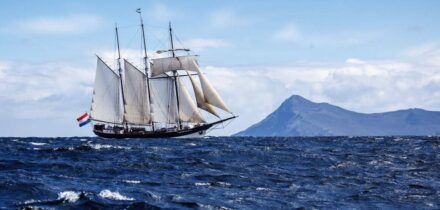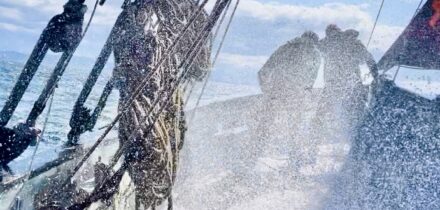The Marine Sextant and how it works
A brass sextant is a beautiful instrument with knobs, slides, Vernier scales, mirrors, magnifiers, filters, lens and eye pieces. It’s a real historic instrument that is still in use today.

Even today big ships are all required to carry working sextants and the navigating officers have regular routines to keep themselves familiar with making it work. Despite all the Global Positioning Satellites, gyro compasses and radio communications it is at the end of the day an instrument that does not require any electricity or power of any sort to make it work. So when all else fails a sextant can still work. Ok there is one other instrument you need when using a sextant and that’s a clock that keeps Greenwich Mean Time to a very high accuracy. Plus you will need celestial tables and a good understanding of how to use the tables or do the calculations from principles. Ah and oh yes you will also need to be able to see things, the sun, moon, stars or bits of land. Not that you will need to see them all at the same time but just one would be helpful.
Taking the noon day sight is the traditional way navigating officers found their position in the old days. See Wikipedia
You can learn how to use a Marine Sextant with this RYA Course.
Ocean Voyages.
You may be able to practice the use of a sextant on one of our OceanVoyages, tell us your interest and we will check for you.
Important Safety Note
When measuring the sun’s altitude, always use the appropriate filters to protect your eyes.
Understanding the Sextant’s Components
A sextant is a precision instrument made up of several key parts:
- Frame – The backbone of the sextant, typically made of brass or aluminium.
- Index Mirror – Fixed to the moving arm, this mirror reflects light from a celestial body.
- Horizon Mirror – Half-mirrored, allowing both direct and reflected views of the horizon.
- Index Arm – Moves the index mirror and is used to measure angles.
- Arc and Vernier Scale – Marked in degrees and minutes for precise measurements.
- Telescope – Helps in sighting celestial bodies more clearly.
- Filters – Used to protect the eyes when viewing the sun.
- Micrometre Drum – Allows fine adjustments to improve accuracy.
How to Use a Sextant
Before you begin, you will need an up-to-date nautical almanac to obtain the celestial data required for accurate position fixing.
Using a sextant effectively requires patience and practice.
Here’s a step-by-step guide to taking a sight:
1. Adjust the Sextant for Index Error Before use, ensure the horizon and index mirrors are properly aligned. Look at the horizon through the sextant and adjust the micrometre drum until both direct and reflected images match. If there is a misalignment, note the index error and correct your readings accordingly.
2. Sight the Celestial Body Hold the sextant vertically and look through the telescope, aiming at the celestial body (such as the sun or a star). Adjust the index arm until the object appears in the field of view.
3. Bring the Celestial Body to the Horizon Move the index arm to bring the reflected image of the celestial body down until it just touches the horizon. Fine-tune using the micrometre drum.
4. Rock the Sextant To ensure accuracy, gently rock the sextant back and forth around the vertical axis. The lowest point of the celestial body should just skim the horizon—this is the precise altitude reading.
5. Read the Angle Measurement Once the celestial body is aligned with the horizon, read the measured altitude on the arc and vernier scale.
6. Record the Time Immediately note the exact time of your sight using a chronometer set to UTC. Accurate timekeeping is crucial for calculations.
7. Reducing the Sight: Calculating Your Position
8. After taking a sight, the next step is to calculate your position. This involves using sight reduction tables or mathematical formulas to convert the observed altitude into a usable position fix.
The steps include:
1. Applying corrections for atmospheric refraction, dip (height of eye above sea level), and index error.
2. Using the Nautical Almanac to find the celestial body’s precise location at the time of observation.
3. Performing calculations to determine your latitude and longitude.
Practical Tips for Using a Sextant at Sea
Practice on Shore First – Before using a sextant at sea, hone your skills on stable ground.
Choose Calm Conditions – Taking a sight on a [itching deck is challenging; pick moments when the sea state allows for steadier readings.
Use Sun Filters – When measuring the sun’s altitude, always use the appropriate filters to protect your eyes.
Take Multiple Sights – The more readings you take, the more accurate your calculations will be.
Keep the Sextant Dry and Clean – Salt and moisture can affect the mirrors and moving parts.



The Various Purposes of the Marine Sextant, a Simple explanation.
If you knew when your local midday was and knew what Midday Greenwich Mean Time is you can tell how far away from the Greenwich Meridian you are.
For instance Classic Sailing’s office is near as damn it 5 degrees West. So midday here is 20 minutes after those of London.
Simple maths, there are 60 x 24 minutes in a day, 1440, minutes and there are 360 degrees going right around the world. So for every degree its 1440 / 360 = 4 minutes. Thus 5 degrees West is 5 x 4 = 20 minutes. Which may explain why Cornwall is always a little backward!
So how do you know when it’s your local midday. That’s when the sextant comes into use.
Basically a sextant measures the angle between two things. In this instance it is the angle between the horizon and the sun.
Checking to see you have sun-light filters in place, you look through the sextant and adjust a mirror to superimpose the image of the sun and the horizon. (The filters stop the sun blinding you.)
Watching carefully you will see the sun climb in the sky, keeping adjusting your mirror angle you will notice it stop climbing and begin to drop down again. Noting the time of the highest point gives you the local time of midday. In addition the angle of the sun will tell you how far south or north of the equator you are taking into account the date and various other considerations.
Moon and Stars
So that is the most common usage of the sextant, but what if it’s cloudy and you can’t see the sun? Well that’s when you may need to wait until the sky clears at night time. Then you can take a sighting of a star or even the moon if you are very clever. Using your Nautical Almanac to work out where you are.
The sextant is the development of an older instrument called a Falstaff which measured the angle of the sun from the length of its shadow but that was always a bit tricky at sea. Indeed the sextant did not come into its own until accurate time could be kept but that’s another story.

Land Ahoy
So far, we have mentioned measuring the angle between the horizon the sun, moon and stars but it can also be used on its side. For instance you are approaching land and you see two known mountain tops. If you measure the angle between them and use a compass to point to one of the mountain tops you can then use the compass bearing and the sextant angle to draw your position on a chart.
How Far Away
With the sextant vertical you can measure the angle created between the horizon and the height of a known object such as a lighthouse, hill or mountain top. You do need to know the tidal height as well but you can then work out how far away from the observed object you are
Chase me if you can
In the old days when one vessel was chasing or being chased measuring the angle of the mast head from the horizon would tell you very quickly if the other vessel was getting closer or going further away and by measuring the difference over a short time you could learn how much slower or faster than you they were. Particularly useful when the other vessel is a long way off and judgment by eye alone is difficult.
If you watch my favourite film you will see it in practice, “Master and Commander – Far side of the World” staring Russell Crowe and adapted from parts of the amazing 21 book series by Patrick O’Brian.
A sextant has some advantages over a GPS.
-
- The Americans can’t turn it off. (The European Galileo GPS system is not fully functionable yet and the UK one is pie in the sky!)
- If you loose your power but you still have an accurate clock with Greenwich Mean Time. You can work out your position using the sextant and the correct paper tables for your approx. position and the correct date.
Using a sextant on a Yacht
Yachts have been known to lose their electronics, they do not have room for two totally independent power generators that you would find on merchant or navel ship.
It does take a lot of skill taking sights on yacht that’s bobbing about on the waves.
Now you should try putting into practice the Many Uses of the Marine Sextant!
Many of the Classic Sailing fleet carry a sextant onboard, if you are interested in putting theory into practise then the best voyages are likely to be ocean crossings where there is plenty of time to absorb the theory and put it into practise.
You can learn how to use a Marine Sextant with this RYA Course.
Ocean Voyages





